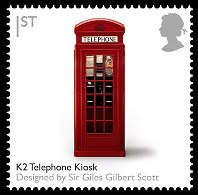Back to Home Page / Kiosks Home Page
Advertising / Alternative Uses / Articles 1 / 2 / 3 / Curiosities / Film & TV / Gallery / History / Novelties / Provenance
Articles of interest concerning Telephone Kiosks everywhere and our Telephone Kiosk endearingly referred to as 'El Tel'.
2021 - TOM UTLEY: From playing the sax to losing your virginity, phone boxes call us all back to our youth
By Tom Utley for the Daily Mail |Published: 11th November 2021 | Updated: 12th November 2021
Younger readers, brought up in the age of the mobile phone, may perhaps be baffled by this week's extraordinary outpourings of affection for that increasingly unnecessary item of street furniture — the public telephone box.
Why, they may wonder, are campaigners up and down the country battling so fiercely to save these relics of a past age from the scrapheap? And why do so many of my generation (I'll be 68 later this month) hold such a special place for them in our hearts?
All week, since the decision by the communications watchdog to protect some 5,000 of BT's public phone boxes from closure, radio stations have been deluged with calls from listeners, recounting fond memories of the part these boxes have played in their lives. A typical example was the story told by Geoff, who rang the BBC's Today programme on Wednesday to tell how he had been banned from playing his saxophone in the flat when he stayed on the Isle of Wight 25 years ago. The neighbours couldn't stand the din, because it was a 'big echoey place' — and as he frankly admitted, he was new to the saxophone and 'not making a very good noise'.
'Younger readers, brought up in the age of the mobile phone, may perhaps be baffled by this week's extraordinary outpourings of affection for that increasingly unnecessary item of street furniture — the public telephone box.' - image and strapline as used in the Daily Mail article with thanks - image © BT Corporate Pictures (no link available)
Shelter
So one winter's evening, he took his music and started practising in the telephone box opposite, where at least he had light and shelter. 'Nobody seemed to bother me,' he said. 'Occasionally people went by and looked at me as if I was a bit mad. 'A policeman stopped once and said, "I suppose it's OK so long as you vacate the phone box if someone needs it" and passed on his way.' But you don't have to listen to phone-ins to hear stories of some of the unusual uses to which phone boxes have been put. And, no, I'm not thinking only of their once widespread use as places for prostitutes to advertise their phone numbers and (to judge by the smell) for antisocial tramps to relieve themselves. Asking around among friends this week, I was surprised to learn from a fellow whom I have always regarded as the soul of respectability that one dark night, long ago, he lost his virginity in a phone box. I really wouldn't recommend this to anyone. Not only does it sound madly uncomfortable to me, but I find it highly unlikely that any passing copper would be prepared to turn a blind eye. Another friend tells me that when he was hitchhiking to Devon in his youth, the only dry place he could find to doss down for the night was a telephone box. That was until a passer-by found him slumped in his sleeping bag in that tiny, cramped space and took pity on him, allowing him to sleep on the floor in his lodgings.
As for my own experience of telephone boxes, they were a lifesaver during my childhood in rural Berkshire, when my parents' decrepit car was forever breaking down. I would be despatched on foot to find a public phone from which to summon the AA. There was no more welcome sight, I can tell you, than that illuminated sign saying Telephone above the familiar red box. Another fond memory from those days, which I share with many others of my generation, is of nipping into phone boxes to press button B, which returned users' coins when they failed to get through to the number they called. There was always an off chance that a previous user had forgotten to press it. If so, two old pennies would drop into my clutches — enough to buy eight chewy sweets, at a farthing each. Later, as a cub reporter sent to cover a story, my first job was to locate the nearest phone box, from which to make a reverse-charge call to the copytakers, who would type out my words back at the office. This could be a long, drawn-out process, and I could only grimace my apologies to those scowling in the queue outside.
Memories
But the story that best sums up the central role telephone boxes used to play in the life of our communities was told by a friend who grew up in the rural outskirts of Greater London. She tells me that beside the phone box in her village was a bench, where she and her mates would meet after school. All their mums knew the number of the box, which they would ring to summon their young home for their tea. The nearest child to the phone would answer it with the word 'Bench', in the way that company switchboard operators answer calls with the name of their firm. Fond memories, indeed. But of course all this was before the arrival of the mobile phone made those public kiosks all but redundant for most of us. These days, some 96 per cent of the UK adult population own a mobile. So, too, do nine in ten children under 11. Meanwhile, call volumes from payphones have plummeted from 800 million minutes in 2002 to only seven million in 2020. Indeed, if you're anything like me, you can hardly remember the last time you made a call from a public box. No, the fact is that sentimental memories alone will not keep our beloved phone call boxes in operation.
Nor will the fact that they are aesthetically pleasing. (I'm thinking here of those which have evolved from the beloved K2 design drawn by the architect Sir Giles Gilbert Scott in the 1920s, whose successor the K6 is regularly voted one of the country's top ten design icons, along with the Spitfire, the Mini and the London Underground map). Nor can we comfort ourselves with the thought that this week's ruling by Ofcom will save more than a few thousand of the 21,000 that remain. Indeed, the watchdog's ban on closures applies only to phone boxes in accident blackspots and areas with poor mobile coverage, greater than average use or high rates of suicide.
Lifeline
As Selina Chadha, the Ofcom director of connectivity, explains: 'Some of the call boxes we plan to protect are used to make relatively low numbers of calls. 'But if one of those calls is from a distressed child, an accident victim or someone contemplating suicide, that public phone line can be a lifeline at a time of great need.' As for the rest of them, let's face it, there is precious little hope that many will remain, as adornments to our streets, unless alternative uses can be found for them. The good news is that on that front, there is much to encourage hope. Spurred on by BT's offer to sell phone boxes to community organisations for as little as £1, if they put them to approved socially valuable use, enterprising folk have come up with all sorts of ingenious ideas.
Some of the old boxes have been pressed into service as cubicles for housing defibrillators, to revive victims of heart failure.Others have found a new purpose as centres of exchange, where people can leave unwanted books, records or videos for the benefit of any locals who fancy them. Others have been used as showcases for conceptual art.
So let's keep those ideas coming — and save as many of these icons as we can.
Just one word of warning: if I were you, I wouldn't suggest using call boxes as love nests, dormitories for hikers or even as music practice rooms for aspiring saxophonists. I have a feeling that few local planning authorities would approve.
2021 - Now that's a saucy tale!
Now that's a saucy tale! The quaint village, its phone box library... and a rumpus over some very 'salacious' books
- Mystery visitor is leaving 'pornographic material' in village phone booth library
- Council fears village will become laughing stock over 'salacious adult literature'
- The hunt is on to find out if the culprit is one of the 851 inhabitants of the village
By Alex Ward For The Daily Mail |Published: 12th March 2021 | Updated: 12th March 2021
As libraries go, the one in Hurstbourne Tarrant is rather small. The shelves lined with thrillers, classic novels and children's books are, after all, in a converted public telephone box. But that hasn't stopped the library becoming involved in a whodunnit that is gripping the picturesque Hampshire village. A mystery visitor has been sneaking in and leaving what the parish council describes as pornographic material amid the Dan Browns and JK Rowlings.
'As libraries go, the one in Hurstbourne Tarrant is rather small. The shelves lined with thrillers, classic novels and children's books are, after all, in a converted public telephone box.' - image and strapline as seen on the Daily Mail website - image courtesy & © of Roger Arbon/Solent News & Photo Agency
It says children could see the 'salacious adult literature' and fears the village will become a laughing stock. Six saucy books are believed to have been left on the shelves. They were found by a resident who immediately removed them in disgust and is said to have thrown them in a bin. They have refused to divulge the titles involved, saying they want to avert further scandal.
Now the hunt is on to find out whether the culprit is one of the 851 inhabitants of the village, which is in the heart of the North Wessex Downs Area of Outstanding Natural Beauty and where the average property costs more than £500,000. The parish council issued a plea to residents: 'We love our red phone box library on Church Street but we don't love salacious adult literature being left in there. 'So if whoever is doing so is reading this, please don't keep leaving inappropriate books – the majority of visitors to the phone box are children. And some of them are tall enough to reach the shelves where the books for grown-ups are. Please find another outlet for your collection.' The phone box was purchased by the council in 2019 after the mobile library service fell victim to spending cuts in the county.
Residents are able to borrow the books – which include such bestsellers as Carol by Patricia Highsmith and Bridget Jones: The Edge of Reason – and add a short review when they return them. Hampshire county councillor Kirsty North said she hoped the books had been left as a joke. Mrs North helped find the funds to pay for the telephone box and said it had proved very popular. 'It's a well-used community library,' she said. 'It's close to the primary school so lots of children use it. It's been a success. 'This certainly wasn't what I had in mind when the village bought the kiosk. It's unfortunate that this material has been found there. I should think it's someone's idea of a joke or maybe it's someone who doesn't live in the village.'
2017 - 'They don't like it up 'em you know!'
Sorry - I couldn't resist plagiarising good old Corporal Jones of 'Dad's Army' - this article would have been just up his street!
The English expat who's gone to war with his German neighbours by filling his garden with a life-size Queen and Corgies, Phone Box*, Mini and Centurion Tank
By Amie Gordon For Mailonline and Richard Marsden and Allan Hall In Berlin For The Daily Mail | |
- Gary Blackburn sparked outrage among his neighbours in the town of Kretzhaus
- His garden is an homage to British culture - complete with a model of the Queen
- Also has a telephone box, post box and model cows painted red, white and blue
An English tree surgeon living in Germany has caused uproar by turning his garden into a quirky tribute to Britain – complete with a 52-ton tank on the lawn. Gary Blackburn has also installed a red telephone box, post box and model cows painted red, white and blue.
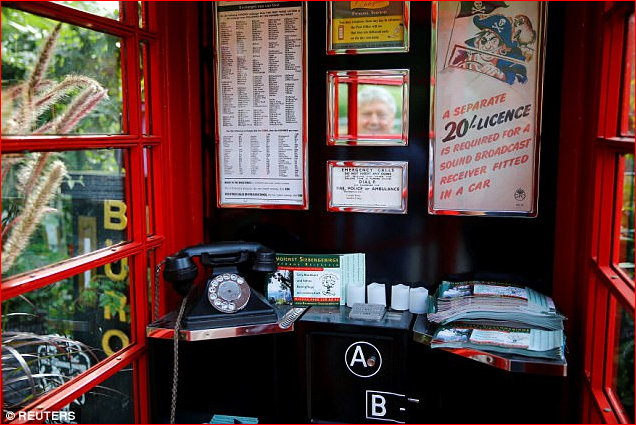
One of the original Trafalgar Square phone boxes at the curiosities collection
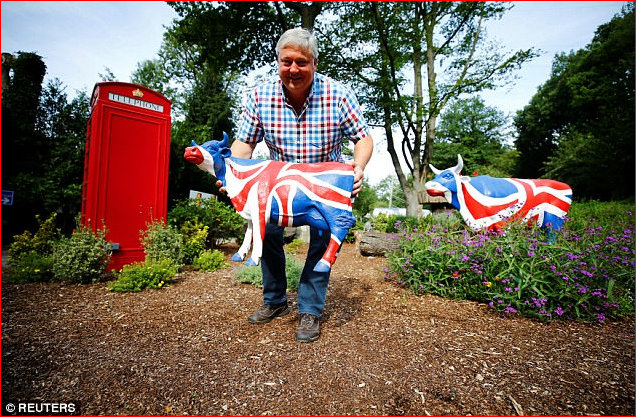
Model cows painted red, white and blue lie around the grounds of his property - images courtesy & © of Reuters
Life-sized models of Queen Elizabeth II and a corgi sit inside his ‘Robin Hood’ log cabin, where there are swords and suits of armour on the walls. On the roof is a model of a propeller plane – though Mr Blackburn has not yet been able to get his hands on the real thing. To complete the scene there is a giant tea set, plus an original lime green Mini bearing the image of Mr Bean. Mr Blackburn recently added yet another item to the collection - a three-wheeled Reliant car like that driven by TV wheeler-dealer Derek ‘Del Boy’ Trotter in Only Fools and Horses. The 53-year-old, who lives in the Rhineland town of Kretzhaus, 20 miles from former West German capital Bonn, said he assembled the British scene as a reaction to the Brexit vote in June last year. Read more
Note : this man is taking my eccentricities to another level! And the 'reporters' should be taken out and chastised for calling a kiosk a box!
2017 - Hanging Up our National Treasure
Hanging up on a true national treasure: We still make 33,000 calls a day from them but a third go unused for weeks. That's why BT bosses are set to remove thousands of classic red phone boxes
- Half of our kiosks are set to be removed from streets due to a lack of use
- British Telecom says it can't spend £6million a year on the rarely used boxes
- Legally, the company can remove any kiosk if there's another within 400 metres
- Out-of-use phone boxes have been transformed into pubs and mini libraries
By John Naish for the Daily Mail | |
Britain is about to look much less British, with thousands of classic red phone boxes set to be removed. In a public survey, they rank alongside Spitfires, the London Tube map and the old Routemaster bus as national symbols. But BT, which owns them, says they’re rarely used and cost £6 million a year to maintain. In all, about 20,000 kiosks — half the total number — are to go, including both modern and traditional designs.
In a sign of our times — an age of mobiles, smartphones and bad manners — public call boxes are more likely to attract people wanting to spend a penny than make a 60p phone call. More than half the boxes lose money and about a third are unused in any given month. But public kiosks still handle about 33,000 calls a day.
Such is public affection that even when taken out of service, they are put to use, including as mini libraries, coffee booths and medical rescue points. Here, John Naish dials up some remarkable facts about these much-loved classics...
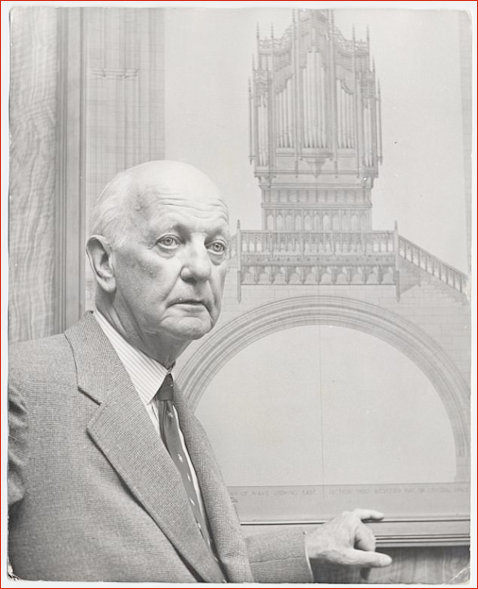
Architect Sire Giles Gilbert Scott wanted telephone kiosks to be silver on the outside - image from Daily Mail article
First call
The first public call offices were established in 1884. It wasn’t until 1921 that the Post Office introduced the first specially designed telephone kiosk. Intended for rural areas, the K1 was made from reinforced concrete and had a spear-like finial on the roof. Only 50 were made, and they were painted a colour to suit the local environment.
Cast-iron guarantee
In 1924, three architects, among them Sir Giles Gilbert Scott, were invited to submit designs for a new kiosk in a contest organised by the Royal Fine Arts Commission. Scott won and his K2 design — made from cast iron with a domed roof — was placed in larger towns, beginning with one in London’s Charing Cross Road in March 1926. Scott wanted it to be silver outside and greenish-blue inside, but the General Post Office insisted on red to make them more visible. More than 1,700 K2s were installed and, although made obsolete in June 1936, 200 remain.
The right red?
Technically, the colour was British Standard BS381C red 538 — until 1965, when it was changed to the slightly lighter BS381C Red 539, or ‘currant red’.
Death calls
The design was based on the mausoleum architect Sir John Soane built for his wife in 1815 — the year of Waterloo. It still stands in the grounds of St Pancras Old Church, Central London.
Royal Crush
A Belfast theatre group holds the record for squeezing people into a traditional box. In 2003, as a stunt for the Edinburgh Fringe, 12 adults and two children crammed into a kiosk on the city’s Royal Mile, beating the record of 12 adults set in Germany in 1997.
Waterloo sunset
The Scottish foundry that produced iron kiosks also cast the Carronade cannons that the Duke of Wellington used at the battle of Waterloo. Falkirk-based Carron Phoenix was once the largest ironworks in Europe and also made red post-boxes. But in 2016, its owners announced the factory’s closure.
Hull and back
One of the 1921 concrete kiosks still stands in Hull’s Trinity Square. The city is one place where iron kiosks are actually making a comeback. Modern ones are being replaced with older boxes as part of Hull’s City of Culture celebrations. But they won’t be red. Hull is the only place in Britain with an independent phone company, and its kiosks are cream-coloured.
Know your Ks
Confusingly the third design (in 1927) was called K4 and the fourth was K3 (in 1929). As well as using the larger K4 to make calls, users could buy stamps and post letters in this miniature Post Office. It was nicknamed ‘The Vermilion Giant’ because of its colour and flame-red interior. But there were complaints about the noise of the stamp machines and that wet weather made the stamps damp. In 1935, the Post Office took the K4 out of service. Next up was the K3, also designed by Sir Giles Gilbert Scott but made from (cheaper) concrete and grey with red window frames. Of the 12,000 installed a few remain, including one in the penguin enclosure at London Zoo.
Crowned heads
After K5 in 1934 — a transportable kiosk designed for public events, such as exhibitions and fairs — came the K6 model a year later. It has a royal crown, modelled on the Tudor crown, above the door. The Queen changed it to St Edward’s Crown, as used in coronations. Scotland opted to keep the Crown of Scotland.
A town’s connection
At their peak, in 1992, before the ubiquity of mobile phones, there were 92,000 phone boxes in the UK — about the same number as the population of Hartlepool. Legally, BT can remove a phone box if there is another kiosk within 400 metres.
Ring last orders
A redundant kiosk in Shepreth, Cambridgeshire, became the Dog and Bone pub for one night. This happened as villagers protested at their local boozer being redeveloped for housing. A carpenter created a triangular bar to allow staff to stand inside while drinkers queued outside on the pavement. Organiser Louise Barrell said: ‘As it was so small, we sold beer in thimblefuls instead of pints.’
Shelved
A red kiosk in the Somerset village of Westbury-sub-Mendip became one of the first to be converted into a library, in 2009, after the mobile library service stopped visiting. Elsewhere, more than 1,000 other village boxes are used as places to borrow books — thanks to BT’s ‘adopt a kiosk’ scheme. For £1, the firm will disconnect the line and hand over maintenance responsibility.
Art attack
Several kiosks have been converted into mini galleries. For example, one is in Upper Settle, North Yorkshire, where the next exhibition will show photos of 28 moth species.
Domino effect
Scottish sculptor David Mach created the permanent work, Out Of Order, in 1989 in Kingston upon Thames, London. It’s a row of 12 phone boxes, the first one upright, the others gradually falling over like dominoes.
Life-saver
A Girl Guides competition in 2011 to find a use for a disused kiosk in Glendaruel, Argyll, led to it being fitted with a defibrillator, which gives an electric shock to the heart to someone who is in cardiac arrest. It can only be accessed by following instructions from the ambulance service via an emergency call. More than 3,000 kiosks across Britain are now fitted with such life-saving equipment thanks to the Community Heartbeat Trust.
Sweet farewell
A phone box by a country road is one of Britain’s smallest cake shops. It opened in April in the tiny hamlet of Cladich, Argyll.
Turncoat!
Several kiosks in London are helping the nemesis of the traditional telephone box — the mobile phone. Lovefone, a mobile phone repair business, operates from several boxes. The company’s Rob Kerr says: ‘Our technician has kept his sanity working in a one-square-metre shop!’
Call of nature
John Long, 73, of Taunton, Somerset, converted a disused box into a loo. He even visited another kiosk at night carrying a toilet pan, to check it would fit.
Long distance
Traditional red kiosks are familiar sights on the streets of Malta, Bermuda and Gibraltar. There’s also one outside the British Embassy in Washington DC.
Novel idea
Baxterley Parish Council, in Warwickshire, granted two writers the use of a phone box to write their novels in 2015. Heide Goody and Iain Grant used it for creative thought, keeping a writing relay going all day, with local writers visiting to help.
AA Box
Comedian Billy Connolly decided to stop drinking when he got stuck in a kiosk after a bender in the Eighties. ‘I made a phone call and I realised I couldn’t get out,’ he said. ‘There was nothing wrong with the box. It simply dawned on me that alcohol doesn’t make you clever.’
Kiosk museum
There’s a National Telephone Kiosk Collection in Bromsgove, Worcestershire, where there’s more than 30 on display. ‘Some children have no idea how to use a telephone dial,’ says Andrew Hurley, its co-ordinator. ‘They were landmarks where people met and romance blossomed. It’s sad they are in decline.’ Source : Daily Mail | Read more from the Daily Mail here
2014 - 'Thingist' Art?
Villagers divided over 'eyesore' tribute to Britain's traditional red phone boxes
From the Daily Mail
To many, the traditional red telephone box is a welcome sight and an iconic British design that ought to be preserved. But when three of the increasingly rare boxes suddenly appeared mounted 20ft in the air on a metal girder in their village, residents of Hurley in Warwickshire were horrified.
The bizarre structure is the work of Barry Robinson, who erected it without planning permission in a field opposite his home. Featuring Union flags attached to two of the boxes, he describes it as a work of art celebrating Britishness.
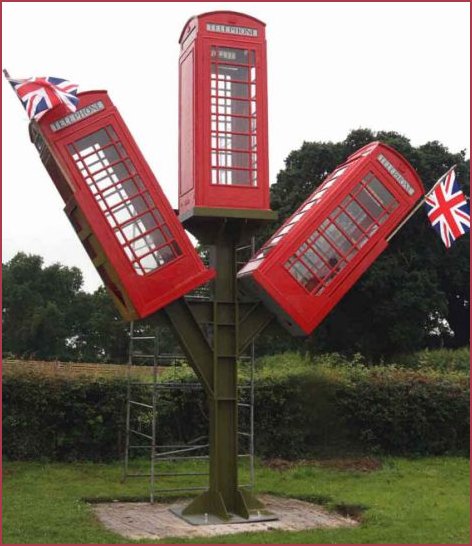
The Telephone Tree: Neighbours believe the artwork is an eyesore that should be torn down
Many his of neighbours disagree, however, and complain it is an eyesore which should be torn down immediately because it lowers the tone.
The tranquility of the rural village has been shattered amid the simmering row while the council decides if Mr Robinson should be allowed to make a retrospective application for his masterpiece, dubbed 'The Telephone Tree'. Mr Robinson, 65, put it up with the help of a crane at the weekend on a patch of green he bought at auction in 2002. Today he said: 'It's my land, why can't I do what I want with it? It's not hurting anyone. It's a tribute to the traditions and heritage of this country and I think it looks marvellous.
'The idea is to preserve the past for the future generations. Whenever people from abroad think of Britain, the first things that come to mind are red double decker buses, the Houses of Parliament and our red phone boxes. 'Yet we seem to want to do away with our heritage, red phone boxes are almost extinct in this country these days. They are all exported over to America or Saudi Arabia instead.'
Mr Robinson, an electrical contractor who has lived in the village with his wife Shirley for 33 years, started collecting old phone boxes four years ago and dotted them around his 150 ft sq patch of land. No one complained until the structure was erected. He said: 'I run a refuge for old phone boxes, they come to me battered and smashed and I restore them and give them a loving new home. 'I've a few contacts in councils around the country who sell them on to me, if I didn't buy them they would most probably end up in the dump.'
His creation features one box from Blackpool, one from Kings Lynn, Norfolk, and one from Rugby, Warwickshire. They are all K6 model boxes, which were designed to commemorate the Silver Jubilee of King George V in 1935 by Sir Giles Gilbert Scott and were the first to be installed nationwide. Campaigners have fought to preserve traditional red phone boxes in the face of their widespread replacement by modern glass-sided booths made of stainless steel. But seeing the traditional boxes displayed in Mr Robinson's structure is the last thing many in Hurley want.
Alan Charsley, 57, whose home overlooks it, said: 'It's an eyesore. I don't really expect to wake up in the morning and open the window to see three telephone boxes stuck up there in a field. 'There's nothing wrong with people wanting to preserve British heritage, there's a time and a place for everything. But if he wants to preserve British heritage why doesn't he donate the telephone boxes to a museum?' Another local resident, who asked not to be identified, said: 'He says it is art, but the dictionary definition of art is not that. Three haphazardly positioned telephone boxes up a 20 foot girder is not art.' Planners at North Warwickshire Borough Council will now have to decide if Mr Robinson is allowed to keep his tribute to British culture.
A spokesman said: 'There have been a number of people contacting us about it. We will now decide if there will be an enforcement act issued to remove it or whether he will be invited to submit a retrospective planning application.'
2012 - Jubilee Year
As the Jubilee gathers momentum, it seems as if the popularity of the red telephone kiosk is escalating on equal proportions. In my own story of our telephone kiosk I mentioned the 'urban myth' of a kiosk 'graveyard' in Hucknall - it may or may not be there, but there definitely is a collection point for derelict kiosks in Newark which is not that far away. Thanks to the Telegraph Newspaper, I am able to share these stories with you.
On the 26th of April the Telegraph ran this story:
2012 - BT puts red phone boxes up for sale for £2000
For the last four years people have been encouraged by BT to adopt their local red telephone box for just a £1 to save them from the scrap heap.
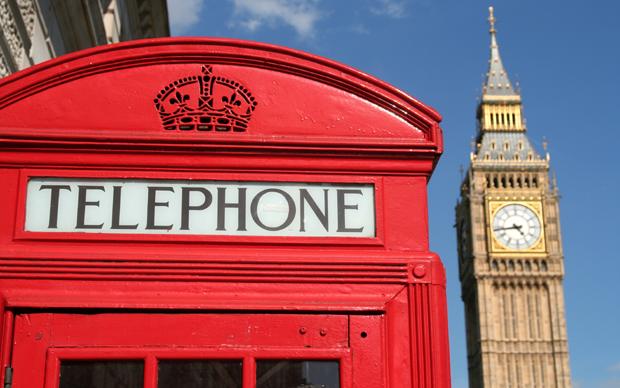
(BT has announced plans to sell off phone boxes for the first time in 25 years. Classic K6 telephone boxes can be bought for around £2,000)
But so popular has the scheme proved that now the telecoms giant has decided it wants to make some proper money from the cast iron designs and is charging £2,000 per box.
Under its “adopt a kiosk” scheme, communities were encouraged to turn them into everything from art galleries to libraries.
But now individuals interested in owning their own “K6” phone box will have to pay £1,950, plus VAT and delivery – which, given each box weighs three quarters of a ton - could amount to a lot. A third party company, X2 Connect, is handling the sales.
The K6, often dubbed the “Jubilee” phone box, was introduced in 1936 to mark King George V’s 25th year on the throne. It was designed by Sir Giles Gilbert Scott, also architect of the Battersea Power Station and Liverpool’s Anglican cathedral, and became the first standardised phone box in Britain.
By the end of production in 1968 there were nearly 70,000 K6 boxes in operation, but these were phased out during the 1980’s in favour of kiosks which are safer because they are open and transparent. There are now just 11,000 of the old K6 boxes still functioning.
More than 1,800 boxes have been bought been taken over by communities for £1, and been put to a broad range of new uses. Some have been fitted with defibrillation units and cash machines and one was turned into a one-night only pub.
2012 - Inside the red phone box graveyard
On 9th May 2012 the Telegraph ran the story of the graveyard.
As the British design classic is given an Olympic spruce-up – and collectors pay thousands to own one – Sarah Rainey visits their secret resting place.
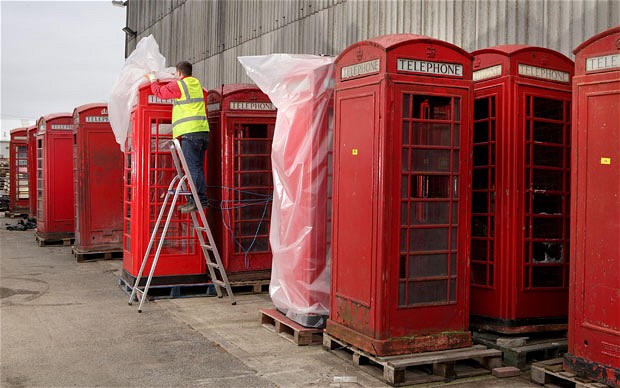
K6 boxes weigh 750 kg and are fitted with cast-iron doors
On a deserted industrial estate in the commuter town of Newark, Nottinghamshire, there is a graveyard. But this is no ordinary resting place for the dead. Few know of its existence; even fewer come to pay their respects. Inside a draughty warehouse, the ground is littered with broken glass, scraps of metal and chipped red paint. Its lifeless inhabitants, their insides stripped out, stand in rows on wooden crates. Body parts are detached, cleaned and stored away in crates lining the concrete walls.
Welcome to the graveyard of decommissioned BT phone boxes. This warehouse, run by payphone specialist X2 Connect, is home to more than 150 of them – from a rare 85-year-old red kiosk to state-of-the-art three-cornered machines. When Britain’s phone boxes become damaged beyond repair, this is where they end up. Disembodied ''telephone’’ signs with faded lettering are scattered around the yard, where a flurry of workers are welding and hammering piles of scrap metal and wood, transforming them into shiny kiosks ready to go back out on the street.
Since last month, when BT announced plans to sell off 60 of its classic red phone boxes, X2 Connect has been busier than ever. For the first time in 25 years, private buyers have the chance to own one of the K6 boxes, designed in 1935 for King George V’s Silver Jubilee, for a starting price of £1,950 – and demand has been huge.
“The phones haven’t stopped ringing,” says managing director Richard Parker, “if you’ll excuse the pun. We’ve had over 600 calls from across the globe – Australia, America, the Far East – from people wanting their own piece of British heritage. Thirty boxes have been allocated already and there are 500 people on a waiting list for the next batch.”
But it’s not just the latest sale of K6 boxes that has meant business is brisk at X2 Connect. Earlier this week, BT announced plans to splash 1,500 litres of red paint on 400 phone boxes in London and Weymouth, Dorset, ahead of this summer’s Olympic Games, as well as restoring 1,300 of its modern grey kiosks in preparation for the flood of tourists to the UK. Rather than getting a new coat of paint every 10 years, the boxes will be refurbished continuously until the end of the Paralympics in September – and that means a busy few months for BT’s contractors.
“We took on remanufacturing all of BT’s kiosks 12 months ago,” Parker explains. “At first it was just to put them back on the streets, but the next few months are shaping up to be hectic. The K6 in particular captures people’s imagination because it’s such a traditional part of British identity, like a post box or Big Ben. When people come to this country, that’s what they want to see.”
There are 60 red K6 phone boxes on site in Newark, each weighing around 750 kilograms and fitted with a cast-iron door. They are stored outside – the mezzanine floor inside wouldn’t hold their weight – in a yard surrounded by a high fence and bolted gates to ward off metal thieves.
“We have to be careful,” admits Parker. “It’s a lot of valuable metal to have in one place.” The boxes arrive in lorry-loads, their concrete bases ripped up from street corners, and are meticulously worked on for weeks by the warehouse’s eight employees.
Sprucing up old phone boxes is no easy task. John Wood, operations manager, says only 75 per cent of kiosks delivered are in good enough condition to renovate – the rest end up on the scrap heap. “Some of them arrive in a terrible state: broken glass, physical damage, all manner of horrible things done inside. We start by taking the doors off, giving them a thorough clean and stripping out the internal fittings. Once all the glass is chipped out of the windows, we send them down the road to a farm to be shot-blasted and repainted.”
The repainting is one of the most important parts of the manufacturing process, as it is the K6’s eye-catching red colour that makes the telephone box so iconic. To ensure uniformity across the country, X2 Connect supplies pots of ''Post Office red’’ paint, the colour that was specially produced 77 years ago for the K6. “You become a bit of an anorak, doing this job,” admits Wood. “I can’t walk past a phone box now without noting what model it is and checking it’s painted properly.”
However, if K6 architect Sir Giles Gilbert Scott had had his way, the classic phone box wouldn’t be red. “He wanted to build on features of the previous models but make the style quite contemporary,” explains Sian Wynn-Jones, heritage collections manager at BT. “While the Post Office liked red, Sir Giles didn’t think it was fitting for his design. He wanted them to be silver with blue and green on the inside, and dove-grey in rural areas.”
Letters from BT’s archives reveal a mixed public reaction to the red kiosks. A Mr Thornley, writing to his MP in July 1936, said the colour was “like an evil deed in a good world”, while John Gloag, a member of the Council for the Preservation of Rural England, described the “vivid scarlet kiosk” as “a piece of agreeable punctuation”.
Areas that did not approve of the colour were allowed to paint theirs – some still remain in dark green and grey. The traditional boxes were very different to today’s models: each contained an ashtray, writing desk, notepad and mirror. “They were a real architectural marvel,” says Wynn-Jones.
Some 70,000 K6s were installed across Britain as part of the first nationwide programme of public telephone kiosks. Now, just 10,770 remain, including two in Normandy, France, that were installed for the 50th anniversary of the D-Day landings, and a few in Malta, Bermuda and Gibraltar. But as payphone use declines thanks to the spread of mobiles, 60 per cent of kiosks are losing money, with an 80 per cent drop in the number of calls made in the last five years. In 2002 there were 92,000 BT phone boxes on our streets; now there are 51,500.
“It’s a dying business, but interest in the kiosks is more alive than ever,” says Parker. “Everyone wants to own a red phone box because it’s a slice of British history, yet what they’re doing with them is very modern – like rejuvenating an old relic. We had one inquiry from a customer in Saudi Arabia who wanted to turn his into a shower.”
Since 2008, 1,800 kiosks have been bought by communities under BT’s Adopt A Kiosk scheme, which this month saw residents of Bucklebury, Berkshire, the childhood home of the Duchess of Cambridge, buy theirs for just £1. Last summer, locals in Shepreth, Cambridgeshire, turned a red phone box into a one-night-only pub, while others have been made into libraries, art galleries and even defibrillator machines.
In Newark, a new delivery of damaged kiosks has arrived in the yard. The tarpaulin of a huge van is pulled back to reveal piles of dented and discoloured red boxes stacked on their sides, their windows smashed and insides thick with grime. “Some of these are at the end of their life, but I reckon we could get most of them up and running again,” says Wood. “They’re thoughtfully designed – their brass fittings don’t corrode – which is why they’ve lasted nearly 80 years.”
BT’s contractors pride themselves in getting as many old phone boxes back on the streets as possible. But not all the red kiosks’ authentic features will remain. “We have to remove lots of literature left by ladies of the night,” grins Parker. “One of our workers removed the back board from a phone box and hundreds of calling cards fell out – enough to fill two litter bins. His eyes nearly popped out of his head. Customers can request certain fittings in the kiosks – but there’s certainly a limit to how 'authentic’ we’ll make them. We’re trying to make Britain’s phone boxes a better place.”
Fairy Tale Telephone Kiosk
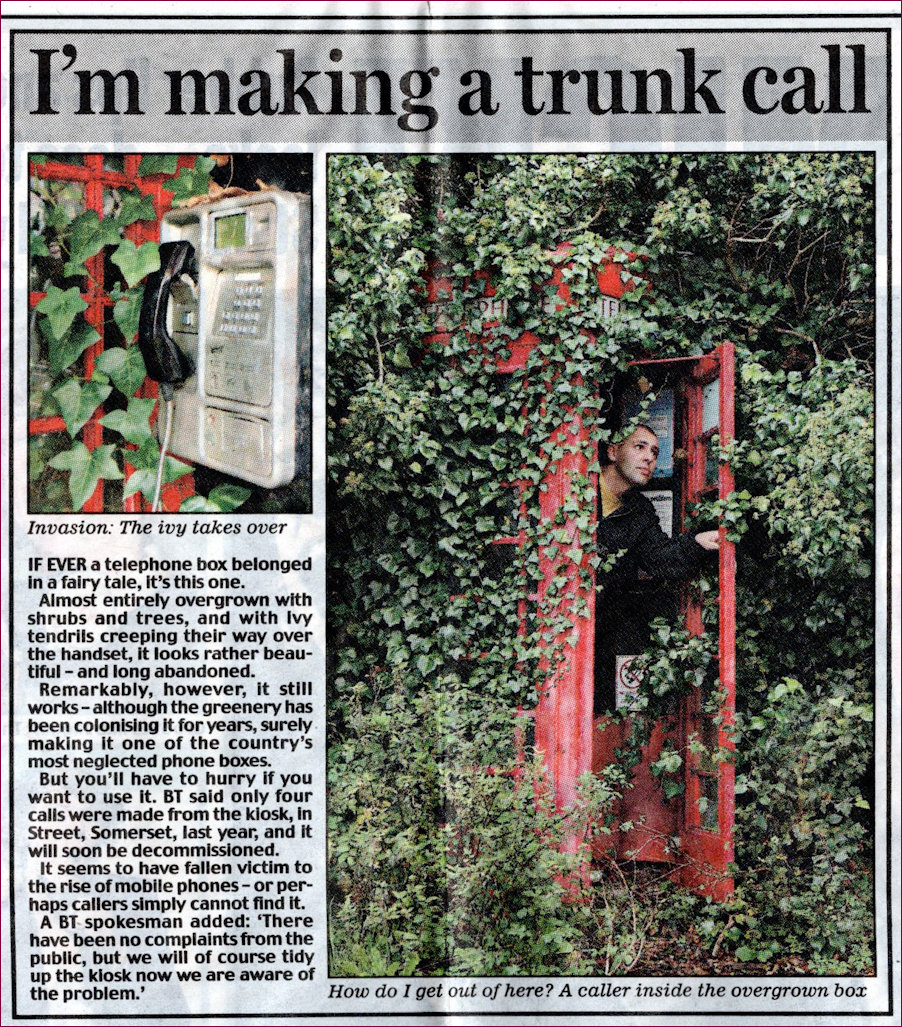
Article scanned from the Daily Mail dated 30th October 2012
2011 - Picture of the Week
Reproduced below is the 'Picture of the Week' as featured in the 22nd July 2011 edition of the Hucknall and Bulwell Dispatch.
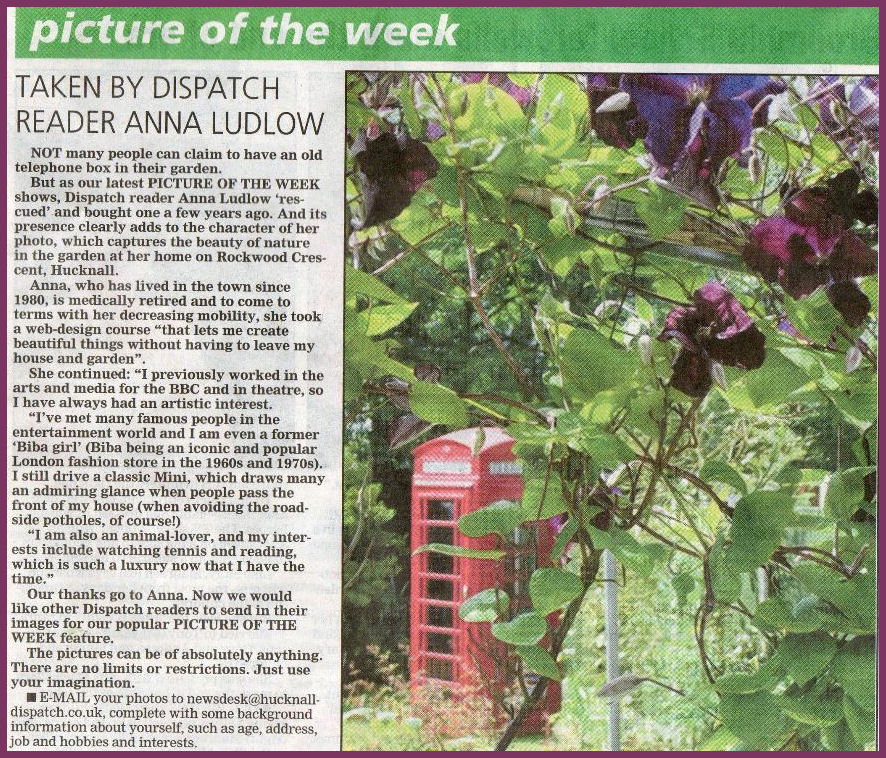
2011 - Christmas Tree has a Red (Telephone Kiosk) Rival
Lighting up Linby Village - Christmas 2011 (oh yes, the Christmas Tree was on the other side of the road!)
Reproduced below is the article as featured in the 16th December 2011 edition of the Hucknall and Bulwell Dispatch.
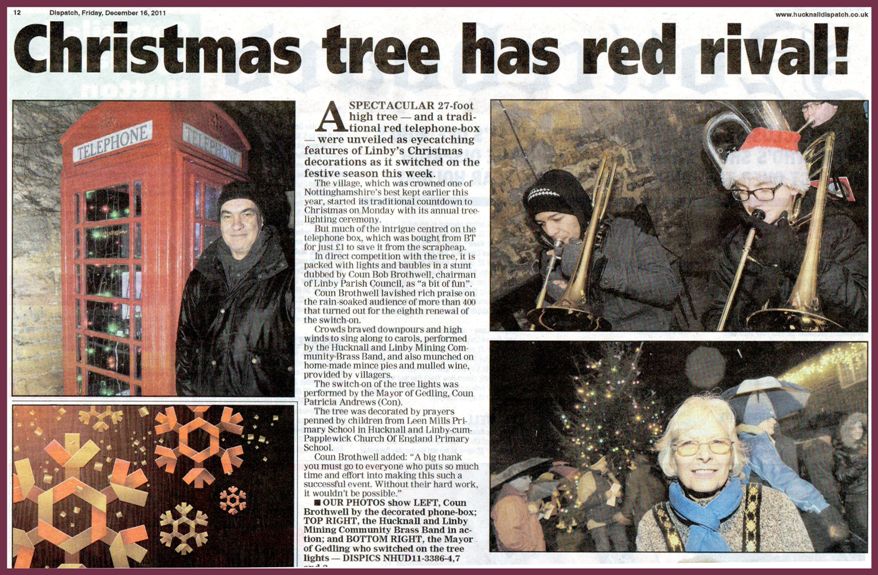
And some of our pictures to show the Kiosk in its Christmas 2011 finery:
From left to right the Kiosk displays a red and green selection of lights which turn to blue and glow eerily but cheerfully in the dark!
1987 - The Storm no one will forget!
The night when Britain lost 15 million trees, thousands of roofs... and all faith in Michael Fish
- Thirty years ago, on the night of October 15 and 16, 1987, hurricane-force winds with gusts of up to 135 mph ravaged England, the Channel Islands and Northern Ireland
- They claimed 22 lives, and caused more than £12 billion worth of damage
- Some 15 million trees were felled across southern Britain
- It was the worst storm for almost 300 years — and forecasters had failed to predict its severity
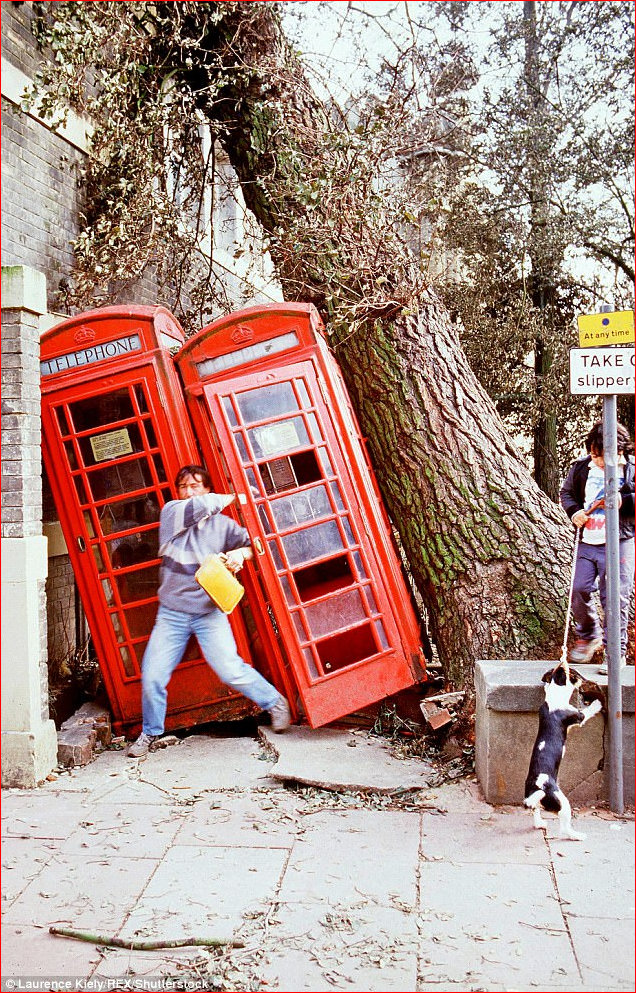
Phone boxes trapped under a tree in Brighton - image © Laurence Kiely/REX/Shutterstock sourced from the Daily Mail
October 15th - 1.25pm - On BBC1, weatherman Michael Fish begins his forecast: ‘Apparently a lady rang the BBC and said she heard there was a hurricane on the way. Well, don’t worry if you’re watching, there isn’t . . .’
- 10.35pm -The Met Office revises its shipping forecast and warns vessels of winds of storm force 10. But as people go to bed, there have been no alerts on the radio or TV of strong winds inland. They have no idea what is about to happen.
- 11.30pm- The Channel Islands are first to feel the storm’s full force. On Jersey, Linda Corby and husband Brian are using the winches on their breakdown truck to move trees that are blocking roads. But as soon as one is dragged clear, they hear another tree fall. Linda is wearing her horse-riding helmet as protection. Suddenly, the wind picks up Linda and sends her flying 20ft across the road and into a tree. She is shaken but OK — the helmet has saved her life.
- 11.45pm - On the final weather forecast for the day on BBC1, Bill Giles says: ‘It looks like most of the strong winds will stay away, although it’s still going to be very breezy up through the Channel and on the eastern side of the country.’
- Midnight
- In Southsea, Hampshire, PCs Steve Woodward and Dave Brown are driving along the seafront at the start of their shift. Their Volvo patrol car is being hit by dozens of beach pebbles picked up by the wind. A set of traffic lights has been bent over almost horizontal, and shop and car alarms are going off in almost every street.
In Worthing, West Sussex, parked cars are pushed across roads by the wind, and at Shoreham Airport, light aircraft are flipping over. Seagulls are impaled on fences and dashed against walls.
- 1.25am - Trees are extremely vulnerable. They are in full leaf and standing in soggy ground as there has been plenty of rain in recent weeks. A train packed with holiday- makers travelling from Victoria Station to Gatwick Airport comes to a screeching halt inside a tunnel. The train has hit a tree that is now wedged under its wheels. The power goes off and the train is plunged into darkness. The passengers hear the wind roaring eerily past the tunnel entrance. The police arrive at Peacehaven Caravan Park. They are shocked to see heavy gas canisters and garden furniture flying through the air. Mahendra has finally found his wife — she was thrown clear when their caravan first started to roll. Of the 200 caravans on the site, only one has survived.
- 1.35am - The Met Office sends a message to the Ministry of Defence warning the weather is so severe that the Army may be needed to help the public.
- 1pm - The storm moves into the North Sea. It is officially over. Eighteen people have died, 15 million trees are lost. It is the worst natural catastrophe to hit Britain since the Great Storm of 1703. The Met Office record book for October 16 has only three words: ‘The Great Storm.’ Source and read the minute by minute account in full here
Page refreshed : 16th November 2021 (G)
The header on this page consists of the stamp design of the telephone kiosk as copyrighted to the Post Office and one of the winter 2010 views of our own 'El Tel' covered in snow.
